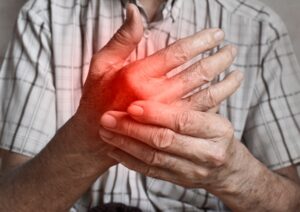Osteoarthritis is the most common form of arthritis that affects millions of people worldwide. At Pacific Arthritis, we understand how impactful osteoarthritis symptoms can be. That is why we provide effective solutions and long-lasting relief to all of our patients in the Greater Los Angeles area.
What Is Osteoarthritis?
Osteoarthritis occurs when the protective cartilage that cushions the ends of the bones wears down over time. Although osteoarthritis can damage any joint, the disorder most commonly affects joints in your hands, knees, hips, and spine. While the damage to joints is irreversible, osteoarthritis symptoms can usually be managed. Common symptoms of this complex disease gradually worsen, including pain, loss of flexibility, and swelling. Our treatment objectives for osteoarthritis includes decrease pain, improving joint mobility and preventing further progression of the disease.
6 Ways To Prevent Osteoarthritis Pain
#1 Weight Reduction
Obesity is widely known as a risk factor for both the development and progression of osteoarthritis. The heavier you are, the worse your symptoms and outcomes can be. Losing weight can reduce the overall severity of arthritis by easing the pain, reducing inflammation, and removing pressure in the problem areas.
As with any weight loss goal, the two main focus areas are eating a healthy diet and increasing physical activity. A healthy diet can help maintain a healthy weight and can also increase the needed vitamins and minerals that naturally support joint mobility. Certain foods such as healthy oils, leafy dark green vegetables, and nuts can be helpful additions to your diet. Other foods are known to contribute to inflammation. Foods that may aggravate your arthritis symptoms include: foods high in refined sugars, fatty foods, dairy products, and alcohol.
#2 Physical Therapy
Physical therapy is guided movement to improve flexibility, strength, coordination, and balance. Your doctor may refer you to a physical therapist that will design a home exercise program reinforcing pain-relief methods, proper body mechanics, joint protection, and conserving energy.
Exercise programs will be customized to your individual needs and abilities with incremental improvements and challenges. Physical therapy not only helps ease arthritis symptoms but may also reduce the need for pain medication and even delay or negate the need for surgery. Physical therapy is often recommended in combination with medications or other treatments.
#3 Exercise To Conserve Joint Mobility And Improve Muscle Strength
Exercise has proven to be a wonderful prevention method for osteoarthritis and related pain. If you currently suffer from arthritis pain, your doctor may recommend that you begin with easy range-of-motion exercises such as low-impact or water aerobics. As you progress and improve, you may choose to participate in more intense exercises such as group sports, weight training, or other activities. The goal of these activities is to strengthen the muscles around the joints and help conserve joint mobility. Exercise not only improves your physical well-being but helps regulate your mood, helps you sleep better, and can increase your energy levels throughout the day.
#4 Nutritional Supplementation
Several nutritional supplements have shown promise for relieving pain, stiffness, and other arthritis symptoms. Glucosamine and chondroitin, omega-3 fatty acids, and curcumin are just some of the natural products that may improve joint stiffness and pain caused by damage to your cartilage. These natural remedies may offer arthritis symptom relief, especially in combination with traditional treatments such as weight loss and physical therapy.
#5 Pain and Anti-inflammatory Medications
In addition to exercise and weight loss, your doctor may prescribe pain and anti-inflammatory medications. Some examples of these medications include:
- Analgesics: These are medicines that relieve pain but do not reduce inflammation. They work to change how your body responds to pain. Popular options include acetaminophen, tramadol, and prescription opioids containing hydrocodone or oxycodone.
- Nonsteroidal anti-inflammatory drugs (NSAIDs): These drugs reduce inflammation and ease pain. These are some of the most common medications given for arthritis. NSAIDs include aspirin, celecoxib, ibuprofen, and naproxen. They are usually taken in pill form and it is important to follow the maximum daily dosage limits for each medication.
#6 Joint Injections
Joint injections are also a proven method for managing arthritis pain.
Two types of injections include medications such as corticosteroids and hyaluronic acid. Corticosteroids (steroids) are powerful medications such as cortisone and prednisone that reduce swelling and suppress the immune system. The effects can be felt in a few days and will last for months.
Hyaluronic acid is a naturally occurring acid in the fluid of your joints and acts as a lubricant. Your doctor may recommend hyaluronic acid injections to help reinflate and maintain the proper amount of lubricant within your joints.
Our doctors and staff are dedicated to your comfort and health. If you have been diagnosed with osteoarthritis or have any of its symptoms, call 310-297-9221 today and schedule an appointment to determine which treatments are best for you.




